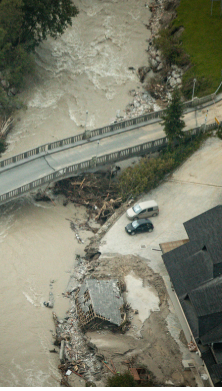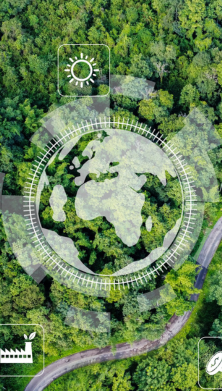- Overall, driving scaled adoption in support and technical functions will play a key role in driving greater efficiency, while also helping rethink operating and business models.
- However, there are challenges to make a success of intelligent automation, to implement it on a large scale and to account for the ESG impacts of it.
- The key areas of concern stay: privacy, security, increased energy demand and e-waste. Businesses will have to think and implement new solutions to benefit from the ditgitalisation and to mitigate their negative impacts.
Key findings
Introduction
2020 is likely to mark another milestone in the digital evolution. With changes in IT accelerating at an ever-increasing rate, so too will society and the environment as they respond to each major development. From a sustainability perspective, looking at 2020 and beyond, it still seems to be unclear how each of these new technologies, as well as digitalization as a mega trend, will play out. What are the specific advantages and potential negative impacts associated with digitalization and sustainable development? Are companies fully aware of the environmental, social and governance (ESG) “side effects” from new technologies?
We observe new trends, technologies and business models giving rise to breakthrough ideas, products and markets. Current innovations can be the right tool to tackle the most complex problems across our society and the environment, though they can also contribute to these problems.
"Internet of Things" - number of connected devices worldwide 2015-2025


1. Machine learning and artificial intelligence for better planning and performance
The utilities sector

A global Finish energy storage company, uses machine learning to manage energy storage systems and broader energy ecosystems. For example, it provides its software to the Spanish island, Graciosa. The new “Graciosa Hybrid Renewable Power Plant,” with its integrated 6 MW/3.2 MWh energy storage management system, can supply 1 MW of solar and 4.5 MW of wind power to the local electricity grid, reducing the island’s reliance on imported fossil fuels and significantly cutting down on greenhouse gas emissions.
Hydro turbine units are highly reliable with only a few examples of unplanned downtime. However, due to the high cost of failures, reliable predictive analytics represented a significant opportunity for the industry. In 2018, a hydro utility had an unplanned outage with an estimated $1.5M impact. Solution: The company evaluated how machine learning could predict uncommon failures with sparse data. An AI solution has identified the large scale outage with one month advance warning.
According to the Capgemini “Intelligent Automation in Energy and Utilities” Report, the energy and utilities sector could realize cost savings from $237 billion to $813 billion, if it were to implement intelligent automation in its target processes at scale. Among the front runners in the implementation of intelligent automation at scale are USA, France, India, Germany, UK, the Netherlands and Sweden.
Water management
The UK’s largest water utility, recently tested an AI platform to analyze large data sets on factors such as weather, demand for water, pump performance and electricity prices. The information is used to make decisions on the most cost-effective and efficient way to run pumps, detect burst pipes and minimize the risk of discolored water. During the trial, the utility saw energy savings of 22%.
Another UK-based water company, created an advanced detection model that uses data from its network to help identify, locate and manage leaks. The time it takes to find leaks has been reduced by over half and it has reduced leaks by over 16% in areas where it has been piloted.
Challenges
Technologies, such as automation and AI, are playing a pivotal role in managing the balance between demand and supply, boosting efficiencies throughout the value chain, innovating the customer experience and transforming business models. According to the IEA, the increasing use of digital technologies across the economy improves efficiency and facilitates the flexible operation of power systems, but also creates potential new vulnerabilities that need to be addressed.
Over the past 10 years, the electricity sector has experienced significant cyber-attacks. In 2010, the Stuxnet computer virus caused significant damage to Iran’s nuclear power centrifuges which were manipulated to spin out of control. In 2014, a team of hackers cancelled approximately $650,000 of electricity bills due to be paid to a Turkish energy company.
The electricity sector has always been heavily interconnected with interdependencies across the supply chain, not to mention with other critical infrastructure industries, such as telecommunications, ports and sewage facilities. Businesses should take note that such interconnectivity is increasing and is associated with certain risks like cyber.
2. Environmental impact management
Reforestation

Transparency in the waste management
The rate at which waste is accumulating is turning our towns and cities into dump sites. Nations all over the world are faced with the herculean task of finding convenient and appropriate means of disposing of waste. Blockchain technology, with its unique cryptographic chain, may offer new possibilities to waste management. This may range from integrating the public into waste collection by offering novel reward systems to clearly identifying waste streams. The technology would make it easier to track shipments of waste and recycling as well as help with the regulatory compliance.
Other organizations create solutions that increase visibility and transparency about the lifecycle of waste from producer to landfill. A French company has used blockchain to track each bin on train stations, continuously updating on the amount of each type of waste, who collected it, and how it moves around. This enables station managers to optimize sorting for different waste streams. The Dutch Ministry for Infrastructure is a role model for other government agencies looking to improve their waste management processes. The agency uses blockchain to improve transparency about waste in transit for the waste management industry - developing a custom solution to track waste from producer to landfill.
Challenges
Increased automation brings a number of challenges with it. Key challenges in implementing intelligent automating are the limited efforts to reskill for employees, difficulties in retaining skilled employees, and a lack of coordination across different business units. Considerations around security and legacy system integration are still stumbling blocks for „those beginning to make use of the technology. Critical challenges include complex IT security requirements, the significant investment required, integrating automation technology with existing systems and tools.
Additionally, digitalization leads to an increase in energy demand, e-waste and ESG issues in the supply chain regarding the materials needed for the digital solutions. Concerns have been raised about increases in the electricity used by information technologies, data centers, consumer electronic devices. According to a 2014 study, communication networks accounted for 1.7% of the total global electricity use in 2012, and data centers 1.4%. Together these infrastructural forms of consumption were roughly twice that of computers, at 1.6%.
At the same time, ‘smart’ innovations are anticipated to help reduce energy demand. Yet such potential savings, as well as the increasing use of digital services, are predicated upon the continued expansion of digital infrastructures. As a result, it is unclear whether the anticipated benefits will be larger than the negative effects of digitalization in terms of environmental and social impact.
The role of AGCS
AGCS supports its clients to identify and assess material risks and develops recommendations on how to mitigate these risks. In a fast changing world, AGCS identifies emerging issues and develops risk management strategies.
Our consulting team is available at: AgcsSustainability@allianz.com
We are dedicated to deliver the best possible solutions to the management, control and reduction of ESG risks.
References
> Sciencedirect.com (2014). Trends in worldwide ICT electricity consumption from 2007 to 2012. https://www.sciencedirect.com/science/article/pii/S0140366414000619
> Statista.com. Internet of Things (IoT) connected devices installed base worldwide from 2015 to 2025 (2016). https://www.statista.com/statistics/471264/iot-number-of-connected-devices-worldwideTechnology and operations management (2018). https://digital.hbs.edu/platform-rctom/submission/xcel-energy-utilizing-machine-learning-to-efficiently-and-reliably-incorporate-renewable-energy-into-the-u-s-energy-grid/
> Wartsila.com (2018). https://www.wartsila.com/media/news/03-12-2018-greensmith-energy-delivers-enhanced-energy-management-software-platform-gems-6-2336044
> Wartsila.com (2018). https://www.wartsila.com/twentyfour7/energy/graciosa-on-the-path-to-100-renewable-energy
> World Economic Forum (2019). https://www.weforum.org/agenda/2019/03/hackers-are-causing-blackouts-it-s-time-to-boost-our-cyber-resilience/















